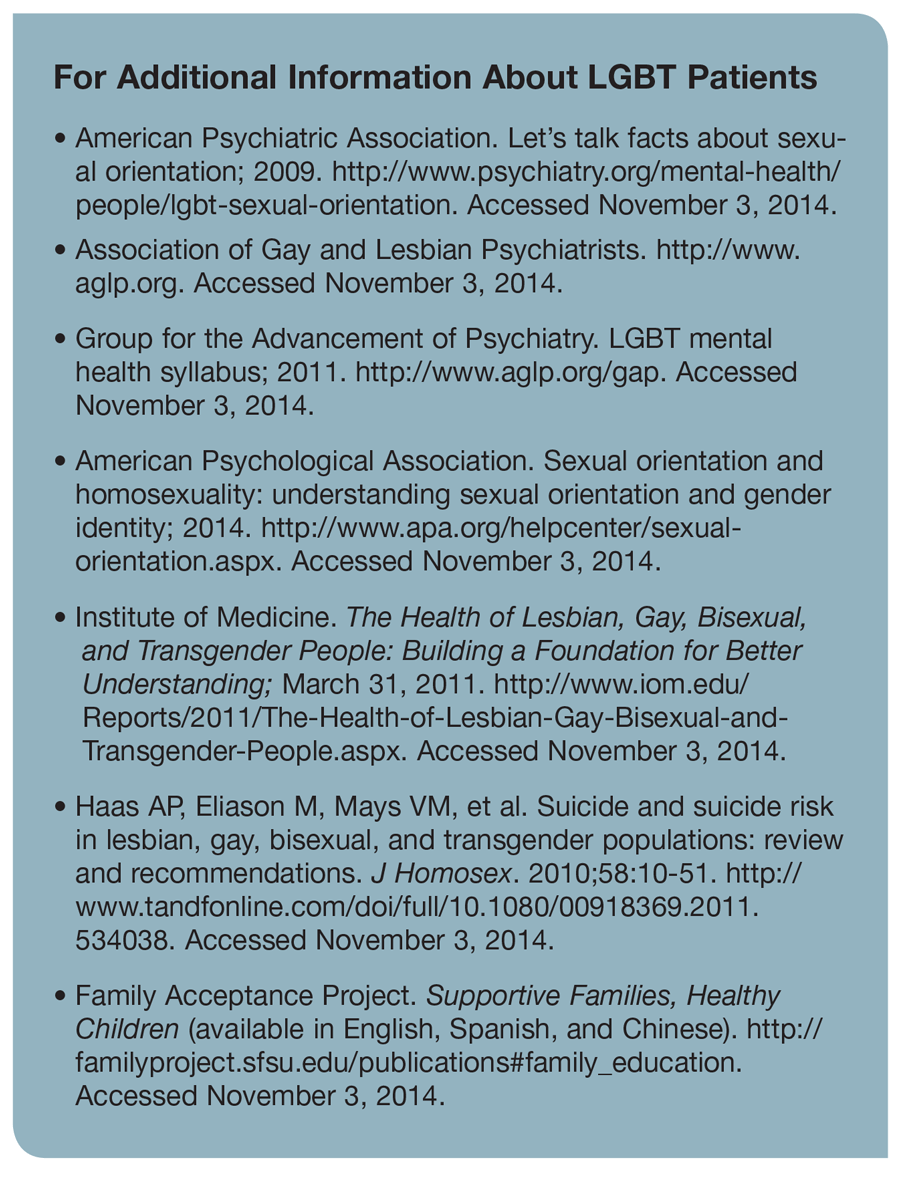Publication
Article
Psychiatric Times
Impact of Sexual Orientation and Gender Identity on Suicide Risk: Implications for Assessment and Treatment
Author(s):
This article reviews what is known and unknown about LGBT suicide risk, discusses risk and protective factors for LGBT adolescents and adults, and provides recommendations for assessing and treating LGBT patients.
For Additional Information About LGBT Patients

Evidence indicates that lesbian, gay, bisexual, and transgender (LGBT) populations are at increased risk for suicide.1 This article reviews what is known and unknown about LGBT suicide risk, discusses risk and protective factors for LGBT adolescents and adults, and provides recommendations for assessing and treating LGBT patients.
Sexual orientation and gender identity
Researchers measure sexual orientation on the basis of sexual behavior or sexual identity. The two constructs identify different populations, however. An estimated 8.2% of US adults report lifetime same-sex sexual behavior and 3.5% identify as lesbian, gay, or bisexual.2 Sexual attraction is also used to measure orientation, although this is even less definitive of minority sexual identity than sexual behavior.
The prevalence of transgender people in the US is estimated at 0.3%.2 This includes individuals who transition from natal sex to another distinct gender (usually with transition-related health services) and persons who are transgender part-time, who cross-dress, or who identify as gender-nonconforming. Gender identity and sexual orientation are different but sometimes overlap. In one survey of transgender adults, 71% identified as gay/lesbian, bisexual, or “queer”; 23% as heterosexual; and 6% as asexual or other.3
[[{"type":"media","view_mode":"media_crop","fid":"30578","attributes":{"alt":"","class":"media-image media-image-right","id":"media_crop_4089569507131","media_crop_h":"0","media_crop_image_style":"-1","media_crop_instance":"3211","media_crop_rotate":"0","media_crop_scale_h":"262","media_crop_scale_w":"235","media_crop_w":"0","media_crop_x":"0","media_crop_y":"0","style":"float: right; width: 150px; height: 167px; margin: 1px;","title":" ","typeof":"foaf:Image"}}]]Suicide deaths in LGBT populations
Because sexual orientation and gender identity are not systematically recorded at time of death, the number of LGBT deaths from suicide (or any other cause) is not known. This is a barrier to understanding and addressing LGBT suicide risk. Studies asking whether LGB people are over-represented among suicide decedents have produced inconsistent or inconclusive findings. However, high rates of suicide have been reported among individuals receiving medical interventions for gender transition.4,5 Findings from a recent Australian study indicate that depression, relationship problems, and other life stressors were more prevalent among LGBT suicide decedents than among non-LGBT decedents, and the LGBT decedents were less likely to have received psychiatric treatment.6
Attempted suicide in LGBT populations
There is strong evidence of elevated rates of suicide attempts in sexual minorities. Lifetime suicide attempts, on average, are 4-fold higher in gay and bisexual men, and twice as high in lesbian and bisexual women, compared with heterosexuals.7 Among adolescents, those who are LGB report making a lifetime suicide attempt at 3 times the rate of heterosexual youths.8 Moreover, LGB youths report 4 times as many medically serious attempts. Recent research suggests adolescent suicide risk is more strongly associated with LGB identity than with same-sex sexual behavior and is higher in behaviorally bisexual youths than in those with exclusively same-sex sexual behavior.9,10
Surveys of transgender adults likewise suggest high rates of suicidal behavior in gender minorities: lifetime suicide attempts have been reported by 25% to 43% of respondents.11 While the self-identified samples may not be representative of transgender populations as a whole, the consistency of survey findings suggests lifetime suicide attempts are likely more prevalent in transgender individuals than in the US general population, in which suicide attempts are reported by fewer than 5% of adults.12
Risk and protective factors
The higher prevalence of suicide attempts in LGBT adults and adolescents has been linked to the higher incidence of mental disorders in these populations-in particular, depression, anxiety, and substance abuse.7,13,14 High rates of depression and panic disorder have been observed among gay and bisexual males, while substance use disorders are more prevalent in lesbian and bisexual women than in heterosexual women.7 These findings suggest different gender patterns among LGB persons than among the population as a whole, which may be related in part to lower tolerance of sexual orientation differences in men than in women.
Meyer’s minority stress model15 attributes elevated rates of mental disorders and suicidal behavior in sexual minorities to greater exposure to prejudice, discrimination, and victimization as well as to internalization of negative social views. Hatzenbuehler and colleagues16,17 found that discriminatory laws and policies increase the prevalence of mental disorders in LGB adults. Hatzenbuehler18 also observed increased suicide attempts in LGB youths who lack supportive social environments, including protection against bullying and discrimination. Family rejection is also strongly related to depression and suicide attempts in LGB youths.19
Concealment of sexual orientation (“closetedness”) because of anticipated stigma is also linked to mental health problems.20,21 Nondisclosure of transgender status is associated with lower risk of suicide attempts, possibly because hiding protects against rejection, discrimination, and victimization, which are otherwise strongly linked to suicide attempts in transgender populations.11
Connectedness to sexual minority communities and positive sexual identity protect against suicidal behavior among LGB adults.22 Among youths, protective factors include family connectedness and acceptance; perceived caring of other adults; and school safety, acceptance, and peer support.23,24
Assessment and treatment issues
While assessing suicide risk in LGBT persons can be similar to assessing risk in non-LGBT individuals, there are differences. Individuals in diverse settings may require different approaches, and each population and setting must be evaluated individually. Treatment requires that practitioners be familiar with the cultural milieu of LGBT life.25 Clinicians must be cognizant of the impact that antihomosexual and antitransgender attitudes can have on the normal psychosocial development of LGBT persons; they must also recognize extreme situations that may arise. In addition, they need to be aware of and ask about events that a patient-perhaps in the closet or fearing lack of support from a medical/psychiatric authority-may not offer spontaneously. The following questions are worth thinking about when assessing suicidal risk in LGBT patients.
• Is the adolescent being bullied for gender atypical behavior?
• Has the adolescent been rejected after coming out to a family member or friend?
• Has the adolescent been thrown out of his or her home by unaccepting parents practicing “tough love”?19
• Who should be contacted: the family or social services?
• Is a desperate transgender patient unable to access needed medical care for transition?
• Is a young adult’s suicidal ideation due to using “party drugs” or “club drugs?”
• If suicidal ideation is a response to a recent breakup, can the evaluator talk about same-sex relationships in a nonjudgmental way?
• Has someone “outed” (involuntarily revealed the sexual identity of) a closeted patient who does not want to be out?
• Is the patient so extremely “closeted” and self-loathing that he is socially isolated, with no gay friends?
• Is the patient engaging in unsuccessful “conversion therapy” in an attempt to change sexual orientation26?
• Is the patient experiencing workplace harassment or does he live in a state that does not have antidiscrimination protections for LGBT people?
• Does the patient live in a state that forbids a legal relationship with a partner’s biological child?
• Are the parents of a transgender child receiving death threats?
These are examples of the special kinds of social problems faced by LGBT patients, and it is highly recommended that clinicians who treat these populations anticipate and understand the potential effects of these stressors on suicide risk.
With the above factors in mind, clinicians need to think about who should be notified for collateral information during assessment. Who knows about the patient’s sexual identity? The adolescent living at home may not be out to his parents. The young adult may be estranged from his biological family, relying on a network of friends (family of choice). Assessing risk may require assessing support networks, if any, other than family and friends, including work, religious organizations, and community groups. While taking a collateral history, informing family members may reduce risk-although for closeted individuals, revealing information about sexual identity to unsuspecting family may have the opposite effect.
Hospital discharge planning that does not take into account the patient’s support system and psychosocial stressors associated with being in the closet may increase suicide risk. After discharge, referral to a therapist culturally competent about LGBT issues who also knows how to treat suicidal patients reduces risk.
Recommendations
In 2011, a groundbreaking Institute of Medicine (IOM) report made policy recommendations to improve the physical and mental health of LGBT populations.27 The IOM recommended research using cross-cutting perspectives, such as minority stress; life course; and demographic features, including racial, ethnic, socioeconomic, and geographic diversity. The IOM also recommended that data on sexual orientation and gender identity be collected in electronic health records (EHRs), when possible. EHRs can be designed to alert clinicians when particularly high-risk individuals are seen, such as those with a documented psychiatric disorder or a history of past suicide attempts.
Disclosures:
Dr Haas is Senior Consultant at the American Foundation for Suicide Prevention. Dr Drescher is Clinical Professor at New York Medical College and Adjunct Professor at New York University in New York. They report no conflicts of interest concerning the subject matter of this article.
References:
1. Department of Health and Human Services, Office of the Surgeon General and National Action Alliance for Suicide Prevention. 2012 National Strategy for Suicide Prevention: Goals and Objectives for Action. Washington, DC: Department of Health and Human Services; September 2012.
2. Gates GJ. How many people are lesbian, gay, bisexual, and transgender? Williams Institute, UCLA School of Law; April 2011. http://williamsinstitute.law.ucla.edu/wp-content/uploads/Gates-HowMany-People-LGBT-Apr-2011.pdf. Accessed November 4, 2014.
3. Grant JM, Mottet LA, Tanis J, et al. Injustice at Every Turn: A Report of the National Transgender Discrimination Survey. Washington, DC: National Center for Transgender Equality and National Gay and Lesbian Task Force; 2011. http://www.thetaskforce.org/static_html/downloads/reports/reports/ntds_full.pdf. Accessed November 4, 2014.
4. Asscheman H, Giltay EJ, Megens JA, et al. A long-term follow-up study of mortality in transsexuals receiving treatment with cross-sex hormones. Eur J Endocrinol. 2011;164:635-642.
5. Dhejne C, Lichtenstein P, Boman M, et al. Long-term follow-up of transsexual persons undergoing sex reassignment surgery: cohort study in Sweden. PLoS One. 2011;6:e16885.
6. Skerrett DM, Kõlves K, De Leo D. Suicides among lesbian, gay, bisexual, and transgender populations in Australia: an analysis of the Queensland Suicide Register. Asia Pac Psychiatry. 2014 Apr 2; [Epub ahead of print].
7. King M, Semlyen J, Tai SS, et al. A systematic review of mental disorder, suicide, and deliberate self harm in lesbian, gay and bisexual people. BMC Psychiatry. 2008;8:70.
8. Marshal MP, Dietz LJ, Friedman MS, et al. Suicidality and depression disparities between sexual minority and heterosexual youth: a meta-analytic review. J Adolesc Health. 2011;49:115-123.
9. Stone DM, Luo F, Ouyang L, et al. Sexual orientation and suicide ideation, plans, attempts, and medically serious attempts: evidence from local Youth Risk Behavior Surveys, 2001-2009. Am J Public Health. 2014;104:262-271.
10. Matthews DD, Blosnich JR, Farmer GW, Adams BJ. Operational definitions of sexual orientation and estimates of adolescent health risk behaviors. LGBT Health. 2014;1:42-49.
11. Haas AP, Rodgers PL, Herman JL. Suicide Attempts Among Transgender and Gender NonConforming Adults: Findings From the National Transgender Discrimination Survey. American Foundation for Suicide Prevention and Williams Institute, UCLA School of Law; January 2014. http://williamsinstitute.law.ucla.edu/wp-content/uploads/AFSP-Williams-Suicide-Report-Final.pdf. Accessed November 4, 2014.
12. Nock MK, Kessler RC. Prevalence of and risk factors for suicide attempts versus suicide gestures: analysis of the National Comorbidity Survey. J Abnorm Psychol. 2006;115:616-623.
13. Clements-Nolle K, Marx R, Guzman R, Katz M. HIV prevalence, risk behaviors, health care use, and mental health status of transgender persons: implications for public health intervention. Am J Public Health. 2001;91:915-921.
14. Mustanski B, Liu RT. A longitudinal study of predictors of suicide attempts among lesbian, gay, bisexual, and transgender youth. Arch Sex Behav. 2013;42:437-448.
15. Meyer IH. Prejudice, social stress, and mental health in lesbian, gay, and bisexual populations: conceptual issues and research evidence. Psychol Bull. 2003;129:674-697.
16. Hatzenbuehler ML, Keyes KM, Hasin DS. State-level policies and psychiatric morbidity in lesbian, gay, and bisexual populations. Am J Public Health. 2009;99:2275-2281.
17. Hatzenbuehler ML, McLaughlin KA, Keyes KM, Hasin DS. The impact of institutional discrimination on psychiatric disorders in lesbian, gay, and bisexual populations: a prospective study. Am J Public Health. 2010;100:452-459.
18. Hatzenbuehler ML. The social environment and suicide attempts in lesbian, gay, and bisexual youth. Pediatrics. 2011;127:896-903.
19. Ryan C, Huebner D, Diaz RM, Sanchez J. Family rejection as a predictor of negative health outcomes in white and Latino lesbian, gay, and bisexual young adults. Pediatrics. 2009;123:346-352.
20. Pachankis JE. The psychological implications of concealing a stigma: a cognitive-affective-behavioral model. Psychol Bull. 2007;133:328-345.
21. Schrimshaw EW, Siegel K, Downing MJ, Parsons JT. Disclosure and concealment of sexual orientation and the mental health of non-gay-identified, behaviorally bisexual men. J Consult Clin Psychol. 2013;81:141-153.
22. Kertzner RM, Meyer IH, Frost DM, Stirratt MJ. Social and psychological well-being in lesbians, gay men, and bisexuals: the effects of race, gender, and sexual identity. Am J Orthopsyhchiatry. 2009;79:500-510.
23. Eisenberg ME, Resnick MD. Suicidality among gay, lesbian and bisexual youth: the role of protective factors. J Adolesc Health. 2006;39:662-668.
24. Ryan C, Russell ST, Huebner D, et al. Family acceptance in adolescence and the health of LGBT young adults. J Child Adolesc Psychiatr Nurs. 2010;23:205-213.
25. Levounis P, Drescher J, Barber ME, eds. The LGBT Casebook. Washington, DC: American Psychiatric Publishing; 2012.
26. American Psychological Association. Report of the American Psychological Association Task Force on the Appropriate Therapeutic Response to Sexual Orientation. Washington, DC: American Psychological Association; 2009. http://www.apa.org/pi/lgbt/resources/therapeutic-response.pdf. Accessed November 4, 2014.
27. Institute of Medicine Committee on Lesbian, Gay, Bisexual, and Transgender Health Issues and Research Gaps and Opportunities. The Health of Lesbian, Gay, Bisexual, and Transgender People: Building a Foundation for Better Understanding. Washington, DC: National Academies Press; 2011.






